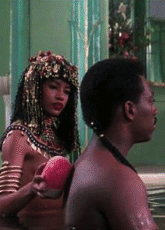Thursday, June 30, 1988
COMING TO AMERICA. Written by David Sheffield and Barry W. Blaustein. Based on a story by Eddie Murphy. Music by Nile Rodgers. Directed by John Landis. Running time: 127 minutes. Rated Mature with the B.C. Classifier’s warning "some very coarse and suggestive language, occasional nudity.”
THE KID USED TO be a helluva team player. Cast opposite Nick Nolte in 1982’s 48 HRS, Eddie Murphy made a real impression.
Cast opposite Dan Aykroyd in Trading Places (1983), the hyperactive young comic displayed something akin to star quality. After that, they started building entire movies around him, movies that made incredible amounts of money and turned him into a one-man industry.
The director used to have a real comic sense. John Landis once turned out funny pictures like 1978’s National Lampoon's Animal House, The Blues Brothers (1980) and An American Werewolf in London. Playful and a genuine film buff, he was full of good ideas. “Trading Places,” he says, "was a 1930s social comedy made contemporary."
A reunion of Landis and Murphy in Coming to America ("a 1930s romantic comedy made contemporary”) read like a good idea. It begins with the traditional tale of an idealistic prince who flees his kingdom and an arranged marriage to seek true love in the new world.
To make its Ruritanian romance "contemporary," the kingdom has been relocated to modern Africa. Murphy plays Prince Akeem of Zamunda. The object of his democratic affections is Lisa (Shari Headley), the strong-willed daughter of Cleo McDowell (John Amos), a Queens, New York fast-food entrepreneur.
The blame for turning a nice idea into a mirthless mess rests squarely on the shoulders of its monomaniacal star, a performer who gets less funny with every film. Here, he favours his fans with an "Eddie Murphy Production" based on a "Story by Eddie Murphy,"
As if that weren't enough, actor Murphy appears in at least four roles, three of them grossly exaggerated. What might have been a gentle, warmly comic film emerges as a muddled, Murphy-centred tour-de-farce.
The tone is set in the first five minutes. To establish Akeem as pampered, there is a reference to his toilet attendants (responsible for wiping the royal backside) and a scene in a pool-sized bathtub introducing the bare-breasted beauty who cleans "the Royal Penis."
What Akeem really wants, of course, is a woman to stimulate his intellect. Accompanying our hero on his romantic quest is his best friend Semmi, played by Murphy's own good buddy Arsenio Hall.
Like Murphy, Hall gets to play several overstated roles. When all is said and done, though, the only one due any credit is make-up man Rick Baker, a prosthetics wizard who manages to make the two actors virtually unrecognizable as bickering barbers Clarence (Murphy) and Morris (Hall), a soul singer (Murphy) and a storefront preacher (Hall).
What Baker can't do is make their antics funny. Nor can screenwriters David Sheffield and Barry W. Blaustein, whose lightweight material never gets in the way of the preening stars.
As for the once-effective Landis, his hand is all but invisible in this tedious tribute to Eddie's ego.
The above is a restored version of a Province review by Michael Walsh originally published in 1988. For additional information on this archived material, please visit my FAQ.
Afterword: “Blaxploitatation is back,” the Los Angeles Times announced in a 2018 feature story. Its bold declaration was prompted by the release of the Canadian-born Director X’s Superfly, a remake of Gordon Parks’s style-setting 1972 feature Super Fly. A separate piece in the same issue of Hollywood’s hometown newspaper told us this “renaissance in black film” had come about as the result of “the massive success of Black Panther [2018] and Get Out [2017] . . .” Because Hollywood considers remakes/reboots the sincerest form of flattery (as well as the least demanding way to realize a profit), 2018 saw the release of Get Christy Love!, a made-for-TV movie inspired by the 1974 TV movie that spawned an ABC series about a female African-American police detective. Announcements then appeared saying that plans to return 1973’s Cleopatra Jones and 1974’s Foxy Brown to the screen were in development.
In 2019, we saw the release of Shaft, with Richard Roundtree reprising his character from 1971’s Shaft, and Dolemite Is My Name, a biographical comedy in which Eddie Murphy plays Rudy Rae Moore, the stand-up comic who had the title role in the 1974 blaxploitation crime comedy Dolemite. At some point, Murphy met with Black Panther director Ryan Coogler and the subject of a Coming to America sequel came up. It probably seemed like a good idea at the time.
Although I have no idea how the current project came about, it really does bring the band back together. After 33 years, actors Eddie Murphy, Arsenio Hall, James Earl Jones, John Amos, Shari Headley and Paul Bates are all reprising the roles they played in the 1988 feature. (The single exception is Madge Sinclair, who died in 1995.) Screenwriters David Sheffield and Barry W. Blaustein are back with a new script. The only key creative individual absent is director John Landis (who is involved in preproduction for a remake of his 1981 feature An American Werewolf in London). Credit for Coming 2 America’s direction goes to Craig Brewer, who worked with Murphy on Dolemite Is My Name.
Blaxploitation, Part 1. Currently included in the Reeling Back archive are five 1972 features from the first blaxploitation move era: Blacula, Cool Breeze, The Legend of Nigger Charley, Slaughter and Super Fly. Also on file are two more released in 1974: Uptown Saturday Night and Together Brothers.
